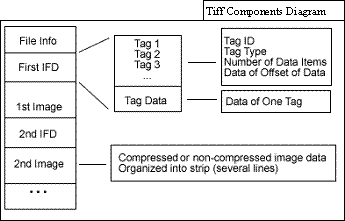Cisco compatible TIFF files can be created by the Black Ice pritner drivers version 9.75 and higher. Cisco routers require a TIFF file in a special format. The Cisco TIFF file begins with an 8-byte TIFF image file header identifier which contains the offset for the first Image File Directory (IFD), followed by the first Image File Directory (IFD), and the Image data. Followed by the next IFD, the next Image data is a chain of images in the TIFF file.

A conventional TIFF file begins with an 8-byte image file header which contains the offset for the first Image File Directory (IFD), followed by the Image data, which is followed by the first Image File Directory (IFD). The actual compressed data is before the Image File Directory (Tags). In the Image File Directory there is an offset for the image which is pointing to the beginning of the file. It looks a little backward, but there is a reason to it. TIFF File format originated in the mid 1980s when memory was very limited. The image was decompressed and compressed from the video buffer. An image was segmented and cut up to strips. Each strip contained 32k or 64k of data and each strip’s offset and length was written into the IFD. As the image was compressed one did not know in advance how big the compressed image data would be. Therefore one could not fill out the IFD tags until the entire image strips were written to the file. Once the image is written to the file then one can write the IFD tags. To make it more complicated each strip in the image header is an entry, so one could not compute how big the IFD would be in advance. Therefore it makes sense to write the image data first, and then write the IFD tags.
Another powerful feature of TIFF is the ability to break an image into tiles rather than scan lines. This allows for efficient access to very large images which have been compressed.
The TIFF specification allows both approaches. The conventional tiff file structure was dictated by necessity at the time. The Cisco TIFF approach is more convenient in an IP application to process the data stream. One can start to decompress the image before the entire image is received since the header information is in front of the image.
Cisco TIFF support is included in the following Black Ice printer drivers: